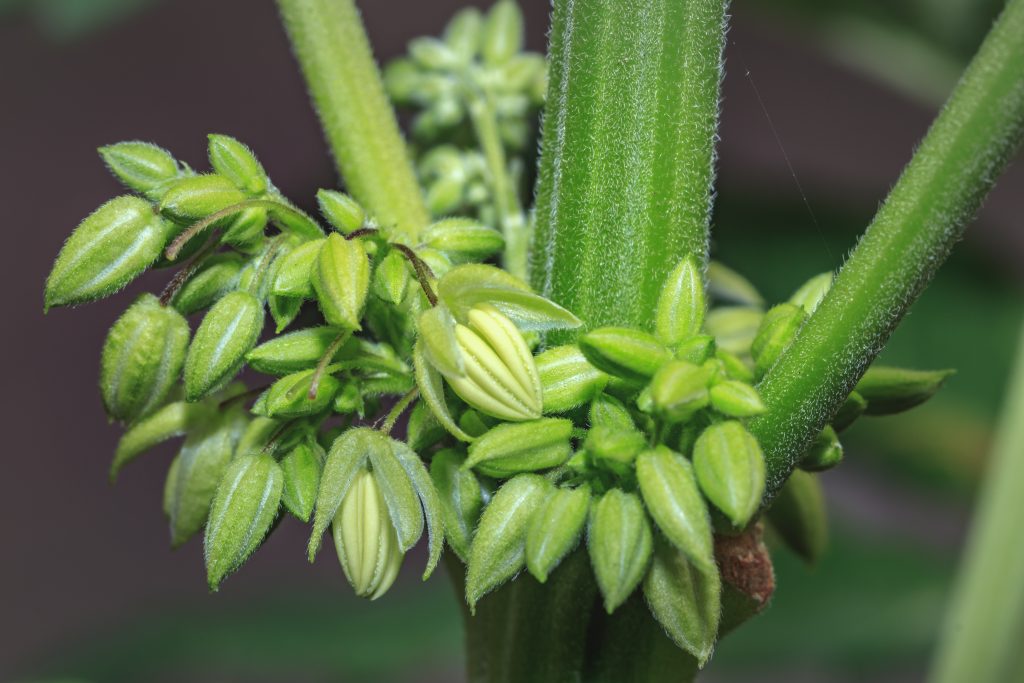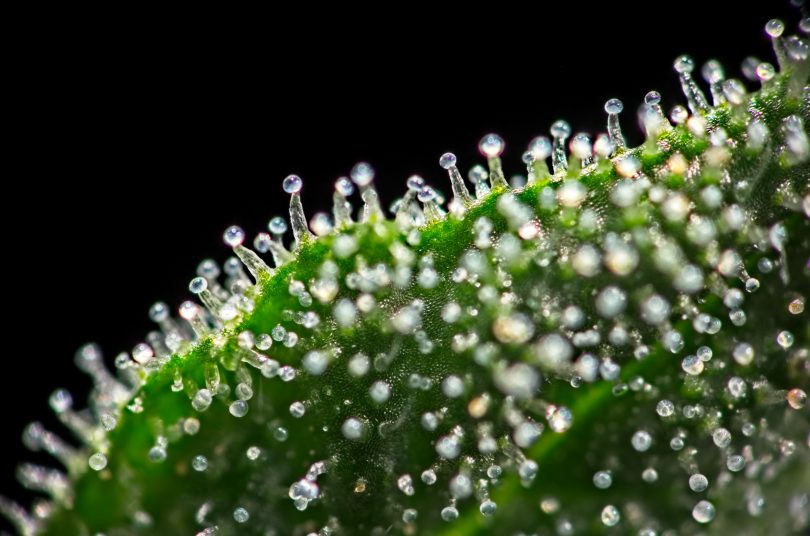Cannabis has been a popular recreational substance for a long time, but the type of weed we consume today has changed dramatically from what our parents and grandparents were smoking decades ago. On average, cannabis available today is about 67% stronger than in the 1970s, and it grows faster and stays smaller in size. Cultivators no longer need 9 full months and space large enough to grow 12-foot-tall plants with buds that only had about 3% THC, if they were lucky. But what factors led to these rapid changes in growth and potency? As it turns out, the secret to getting stronger weed is sexually frustrated female cannabis plants.
As a dioecious plant, yes, cannabis be either male or female, and yes, it can be sexually frustrated. What you’re smoking on right now are flowers from a female plant; and if your current stash is really dank and covered in sticky THC trichomes, then those buds came from a sexually deprived female.
Cannabis is such a fascinating plant and we continue to learn more about it every day. In addition to learning about the plant itself, we also enjoy exploring the wide array of products available on the market today. If you’re interested in trying fun products, rare cannabinoids, and new strains, make sure to subscribe to The CBD Flowers Weekly Newsletter, your top source for all things cannabis-related. If exotic products is what you want, such as Delta 8, Delta 10 THC, THC-O, & THCV make sure to subscribe below to Delta 8 Weekly, and enjoy from our exclusive deals.
Male vs Female Cannabis Plants
Female cannabis plants produce those large, resin-secreting, psychoactive buds. Females are the industry’s superstar because they’re the ones that produce the most cannabinoids. Anytime you buy weed or look at pictures of marijuana with flowers, you’re looking at female plants.
Male cannabis plants do not grow flowers. Instead, they develop pollen sacs around the nodes and tips of the branches, with which they can pollenate any nearby female plants. When female plants are pollinated, they begin to produce seeds, but since no one wants to smoke low-THC schwag with seeds in it, the males are usually thrown out as soon as they are discovered.
NEW: THC-O
Click HERE to get 25% discount on THC-O vape cartridges

On the public side of the cannabis market, females get all the glory. However, when we look more at botany and genetics, male plants have some very important functions as well. Like humans, when a female plant is pollinated, half of the genetic makeup of the seeds produced will come from the male plant. Aside from potency and flavor, many other important characteristics can be passed on from male plants including growth rate, bud size and shape, resistance to mold and pests, and general resilience.
The buds we prefer to consume are seedless female plants with good genetics, referred to as “sinsemilla”, which means “without seeds” in Spanish. To ensure that plants will be sinsemilla females, growers can used feminized seeds or grow clones by replanting small clippings from their existing plants.
How To Tell The Difference
At first, you won’t be able to. Once your plants are roughly 4-6 weeks old and entering the flowering stage, you can start looking for “pre-flowers”. Cannabis pre-flowers are comparable to sex organs, and the females’ look quite different from the males’.
To determine their sex, you’ll need to look between the plant’s nodes (where the leaves and branches extend out from the stalk). Males will have pollen sacs to help spread pollen to the female plants, and females develop two bracts and hair-like stigmas to catch the pollen. Click here for a great guide with photos to help you more easily determine sex.


Sexually Frustrated Females
Back in the 1970s, cannabis growers made a game-changing cultivation discovery: isolating female plants produced extra potent flowers. When females are pollinated, they halt resin/THC production and begin producing seeds. However, when the sexes are separated, females do not get pollinated and thus, they don’t produce seeds and ramp up the resin production. Sinsemilla weed, on average, has a THC content around 6-10% higher than seeded strains.
Simply put, this cultivation method results in ‘sexually frustrated’ female plants. It’s strange, but it works, and the reason for this is because cannabis is one of the few plant species that elicits a physical response to prolonged virginity. Meaning, the longer she feels ‘sexually deprived’, or the longer pollination is put off, the larger and more resinous her sex organs (flowers) become.
Some growers would go so far as to say their plants are somewhat ‘masochistic’, in addition to being horny. Apparently, when the flowers begin to form, some plants will repeatedly bend their branches to the point of almost breaking, a process that helps facilitate resin production in the buds. As one popular Redditor so eloquently put it, “you’re all high on horny plant vaginas.” It’s strangely accurate.
Cannabis Resin, Pollination, and THC Production
Cannabis resin is a rich brown, sticky, gooey substance found on the flowers and leaves of the plant. It’s similar to tree sap, but the main distinction between the two is that cannabis resin is held together by fatty structures called trichomes. These are the plant’s resin glands that contain THC, CBD, terpenes, flavonoids, and other therapeutic cannabinoids and compounds.
To us, trichomes are an amazing and delicious plant byproduct that offers endless medicinal and recreational benefits; but to the cannabis plant, trichomes are one of its most important defense mechanisms. As cannabis flowers develop, they are vulnerable to so much harmful external stimuli such as pests, infections, herbivores, damaging UV rays, and pollution. In the wild, trichomes offer a certain level of protection from all of these things.

Additionally, cannabis resin aids in seed production by catching pollen from the male plants. One male plant can produce an estimated 350,000 pollen grains, and cannabis pollen is airborne so a little bit can go a very long way. As a matter of fact, a study published in 2000 found that cannabis pollen made up just under 36% of total airborne pollen counts in Midwest states during harvest months. This is why it’s important to remove the male plants from the grow area as soon as you determine the sex.
The good news is, you don’t have to go through this process every time you want high-THC, seedless flower. Realistically, isolating your female plants would only be necessary if you’re using the male’s genetics to create new strains. To skip the pollination process, a modern grower can either buy already feminized seeds, or use a clone from an existing female plant.
Hermaphroditic Plants
Cannabis is a bit of a rarity because only about 6% of flowering plants are dioecious. However, on rare occasions, hermaphroditic weed plants containing both male and female parts are known to occur. In general, most plants are hermaphroditic, but this is not very common for cannabis. Sometimes, hermaphroditic cannabis plants can self-pollinate, but they usually produce seeds, lower levels of THC, and they can pass on hermaphroditic genes, so they’re not ideal. Also, true hermaphrodites produce sacs that need to rupture.
There are two types of hermaphrodite plants: those that develop both sexual organs (buds and pollen sacs), and those that develop anthers. Anthers are oval-shaped, pollen-producing sacs found at the end of the stamen. Some growers call them “bananas” because of their elongated appearance.
When cannabis plants turn hermaphroditic it’s sometimes referred to as “herming out”. This is usually a result of excessive environmental stress such as damage to the plant’s physical structure, bad weather, disease, and/or nutrient deficiencies. Bad genetics and previous hermaphroditic development can also be a risk factor. Basically, if you notice any pollen sacs or anthers, get that plant away from your females ASAP.
Final Thoughts on Female Cannabis Plants, Sexual Frustration, and THC Production
To reiterate, if you want big, potent buds that are covered in those flavorful, cannabinoid-filled trichomes, the key is sexually frustrated female plants. Cannabis plants basically live to be pollinated and produce more plants, so when pollination doesn’t occur, the female plant begins to overcompensate by creating bigger flowers with thicker resin.
The fact that cannabis plants are dioecious and respond in such complex ways to sexual stimulation (or lack of it), really makes them even more relatable. We are so incredibly connected to the universe around us which makes it that much more important to understand the complexities of other living creatures.
Thank you for stopping by CBD TESTERS, your source for all things cannabis-related. For more articles like this one and exclusive deals on flowers and other products, subscribe to The CBD Flowers Weekly Newsletter.









